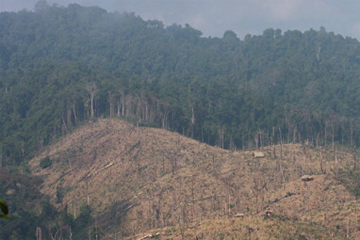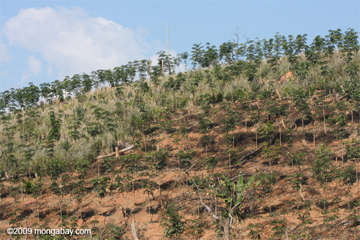Malaysia is systematically replacing its natural forests with plantations of GMO latex-timber clones without affecting official “forest” cover.
|
|
Rainforests once managed for selective logging in Malaysia are now being are clear-felled and replaced with latex-timber clones—rubber trees that yield latex and can be harvested for timber—reports the Malaysian Star. Up to 80 percent of Malaysia’s remaining forest cover could be at risk.
Journalist Tan Cheng Li reports that permanent forest reserves in Selandor and Johor have already been cleared for rubber plantations, while other reserves are now being targeted. Permanent forest reserves are forest areas that have been set aside for selective logging under sustainable forest management. They account for 82 percent of Malaysia’s remaining forest cover.
The development is driven by the government’s effort to expand timber plantations across the country and has been facilitated by a system which classifies single-species monocultures as forests.
  Conversion of natural forest for rubber trees in Laos. Photos by Rhett A. Butler. |
“This labeling has severe repercussion[s]: Forestry Department figures will not show a decline in forest cover despite massive tracts of natural forest being turned into evenly planted rows of rubber saplings,” writes Tan Cheng Li.
“What we’re seeing today is wholesale clearing of permanent forest reserves and massive conversion to plantations,” Tan Cheng Li quoted Surin Suksuwan, Chief Technology Officer at the World Wildlife Fund for Nature, as saying.
The replacement of natural forests with plantations has significant ecological implications. Plantations house fewer plant and animals species and generally store less carbon than natural forests. Clear-cutting also results in soil erosion and increases the risk of fire.
According to the article, permanent forest reserves are also being converted for other types of plantations, including African mahogany, teak, Acacia, sentang, kelempayang, batai, and binuang, although latex-timber clones (LTC) is “favored.” The government plans to have 375,000 hectares of tree farms by 2020.
While there is nothing illegal about conversion of natural forest to plantations under Malaysian law, questions are being raised about lack of environmental oversight. Dylan Ong, an environmental consultant interviewed by Tan Cheng Li, said that while the Department of the Environment requires and Environment Impact Assessment for any logging over 500 hectares in extent, he had yet to see one for a LTC plantation.
“Permanent forest reserves are classified as Environmentally Sensitive Areas Rank Two in the National Physical Plan whereby no development or agriculture is allowed. So all latex timber clone projects in forest reserves should not have been approved,” said Ong.
REDD fears
Some environmental groups fear that Malaysia’s new practice could expand to other countries should current definitions of “forest” be applied under the proposed “REDD” mechanism that is expected to be part of the next framework for mitigating climate change. REDD, which stands for Reducing Emissions from Deforestation and Degradation, is designed to compensate tropical countries for preserving their forest cover, thereby avoiding greenhouse gas emissions from forest clearing. But should monoculture plantations be classified as “forest”, then some NGOs reason that landowners could profit by logging natural forests and replacing them with tree farms to the detriment of biodiversity, carbon stocks, and ecosystem services like erosion control and water provisioning.
Tan Cheng Li. Whither our wilds. The Malaysian Star, 7 July 2009.
Related articles
Asia’s conversion of forests for industrial rubber plantations hurts the environment

(05/21/2009) Policies promoting industrial rubber plantations over traditional swidden, or slash-and-burn, agriculture across Southeast Asia may carry significant environmental consequences, including loss of biodiversity, reduction of carbon stocks, pollution and degradation of local water supplies, report researchers writing in Science. Conducting field work in the Xishuangbanna prefecture of China’s Yunnan province and assessing broader regional trends, Alan Ziegler of the National University of Singapore and colleagues argue that policies favoring agricultural intensification over small-scale slash-and-burn have encouraged the rapid expansion of rubber plantations across more than 500,000 hectares (1,930 square miles) of montane forest in China, Laos, Thailand, Vietnam, Cambodia, and Myanmar. Despite widespread perception among authorities that “swidden cultivation is a destructive system that leads only to forest loss and degradation”, the researchers found that the transition to industrial plantations has not necessarily been a boon to the environment.
(11/11/2008) Scientists should compare the biodiversity oil palm plantations to other industrial monocultures, not the rainforests they replace, said Dr. Yusof Basiron, CEO of the Malaysian Palm Oil Council (MPOC), in a post on his blog. Basiron’s comments are noteworthy because until now he has maintained that oil palm plantations are “planted forests” rather than an industrial crop.